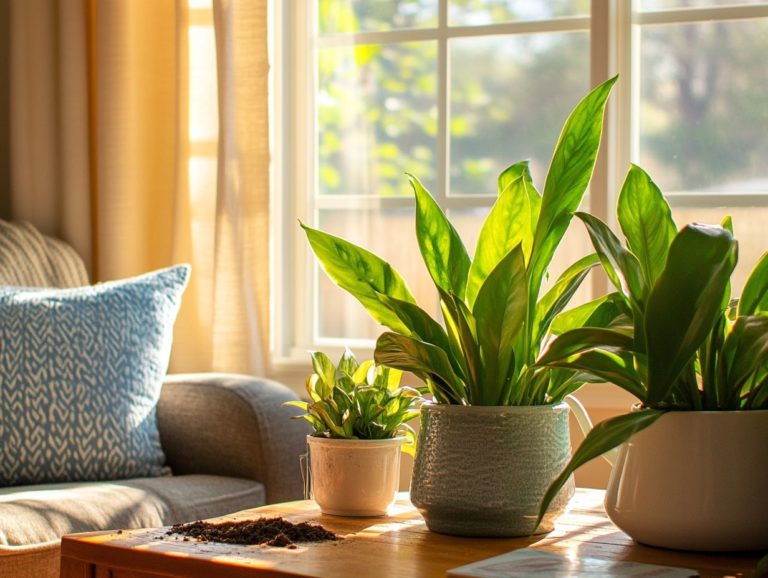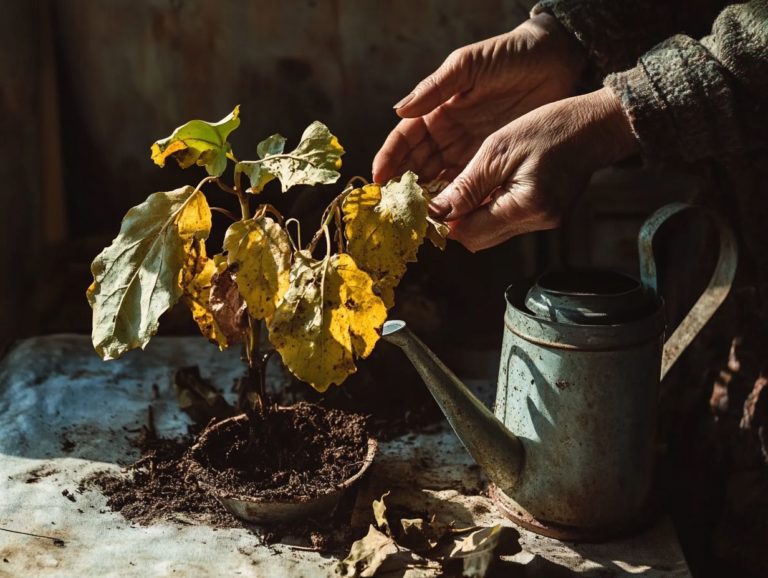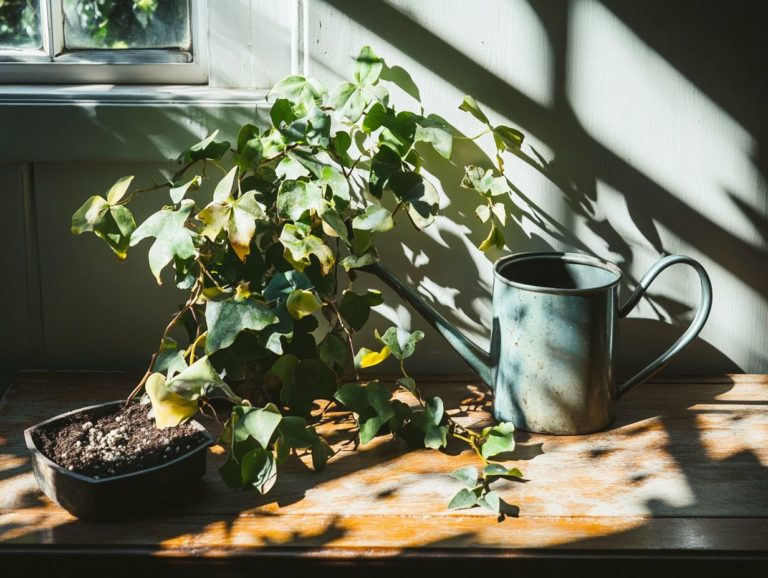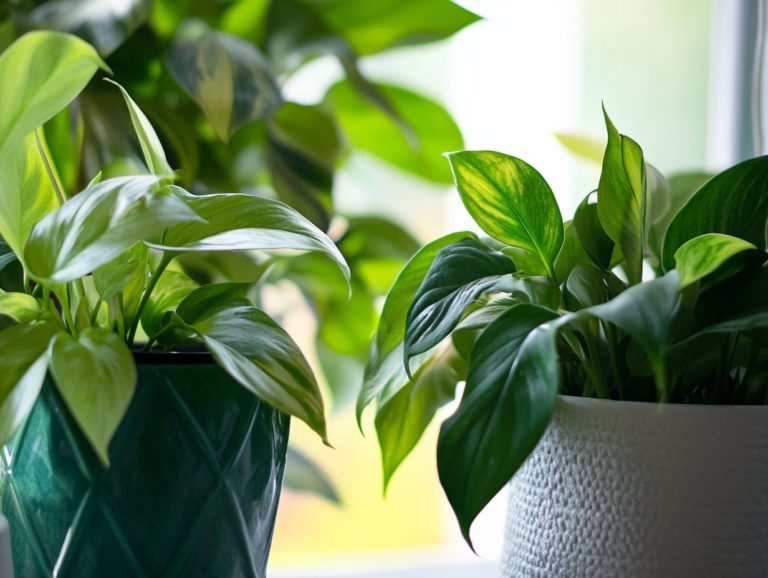Essential Tips for Dealing with Houseplant Issues
Houseplants can infuse your home with vibrant life and fresh air. However, they come with their own set of challenges. From pesky pests to disease outbreaks, various factors can impact their health.
This article offers essential tips for identifying common houseplant issues. It provides preventive measures to ensure your plants flourish. You will discover effective treatment methods for dealing with pests and diseases. You will also learn steps to revive struggling plants and receive guidance on selecting the right houseplants for your unique environment.
Get ready to transform your indoor garden into a vibrant oasis!
Contents
- Key Takeaways:
- Identifying Common Houseplant Issues
- Preventing Houseplant Issues
- Dealing with Pests and Diseases
- Reviving a Dying Houseplant
- Choosing the Right Houseplants for Your Home
- Frequently Asked Questions
- 1. What are some common houseplant issues and how can I deal with them?
- 2. How can I prevent pest infestations in my houseplants?
- 3. Should I repot my houseplants if they are struggling?
- 4. How do I know if my houseplant needs more or less water?
- 5. Can I use household products to care for my houseplants?
- 6. How can I revive a dying houseplant?
Key Takeaways:

- Regularly inspect your houseplants for signs of pests and diseases, such as wilting leaves or discoloration, to catch issues early.
- Proper care and maintenance, such as watering and providing adequate light, can help prevent common houseplant issues and keep your plants healthy.
- If your houseplants do encounter pests or diseases, use effective treatment methods, such as natural remedies or insecticidal soaps, to get rid of them and protect your plants.
Identifying Common Houseplant Issues
Identifying common houseplant issues is crucial for maintaining the health and vibrancy of your indoor greenery. Many of these problems stem from environmental conditions, such as insufficient light, inadequate humidity levels, or improper watering practices.
Recognizing pest and disease symptoms is crucial. This helps you take action quickly to prevent damage to your plants.
Signs like leaf discoloration, stunted growth, and wilting indicate underlying issues that require your immediate attention.
By being attuned to these signals, you can cultivate a thriving plant community within your home.
Pests and Diseases to Look Out For
Pests and diseases rank among the most prevalent challenges that can dramatically impact the well-being of your houseplants. This makes pest identification essential for effective management.
To protect your precious plants, it s vital to familiarize yourself with the warning signs of these unwelcome intruders. For example:
- Aphids: Tiny green or black insects huddled together on young plant shoots.
- Mealybugs: Leave behind a telltale white, waxy coating on stems and leaves.
- Spider mites: Tiny webbing on the undersides of leaves can signal serious trouble.
In terms of diseases, keep an eye out for wilting leaves, which may indicate root rot, and yellowing foliage, a potential sign of nutrient deficiency or a fungal attack.
By employing an integrated pest management strategy, which combines regular monitoring, cultural practices (strategies to enhance plant health), and organic treatments, you can significantly strengthen your plants’ defenses against these threats. This ensures they thrive in all their vibrant glory.
Preventing Houseplant Issues
Preventing houseplant issues demands a proactive mindset, where you implement effective care strategies and ensure proper watering.
Regularly checking humidity levels and providing adequate light boosts your plants vigor. It also reduces the risk of pests and diseases. When necessary, proper repotting techniques can avert root-bound conditions, where a plant does not have enough space in its pot, which can stunt growth. Ensuring good air circulation fosters healthier foliage.
By embracing these preventive measures, you can cultivate a thriving indoor environment for your plants.
Start applying these tips today and watch your houseplants thrive!
Proper Care and Maintenance
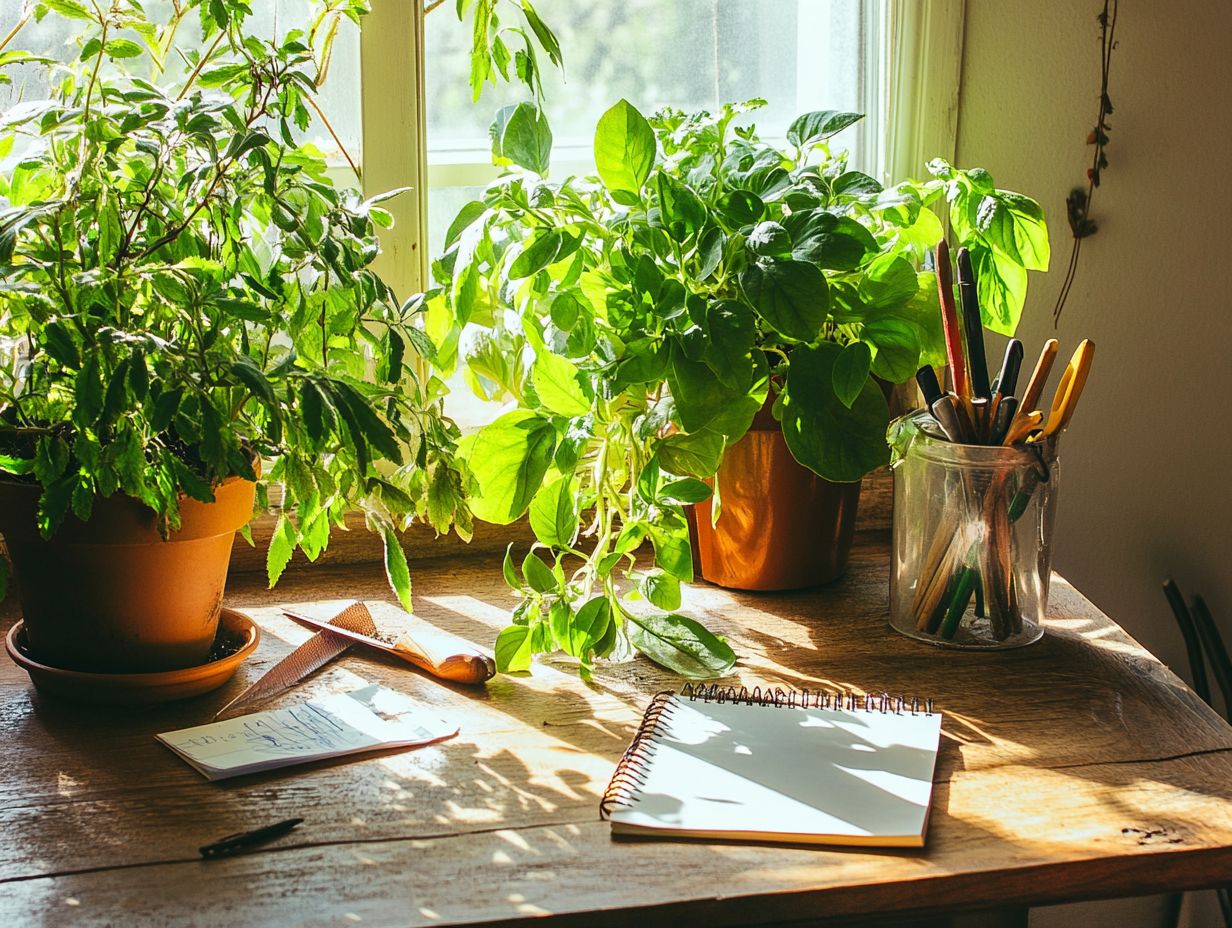
Proper care and maintenance are essential for keeping your houseplants healthy and thriving. Focus on crucial aspects such as soil moisture and nutrient management.
Along with regular watering, employing effective watering techniques is vital. Allow the top inch of soil to dry out before adding more water. This simple practice prevents moisture buildup that can harm root systems.
Periodically assess the soil by checking for compaction and drainage. This ensures that roots can access necessary oxygen and nutrients.
Strategic pruning goes beyond mere aesthetics; it encourages fuller growth and helps the plant redirect energy toward healthier shoots. When nutrient deficiencies surface, incorporate slow-release fertilizers or organic compost. This provides a steady supply of essential nutrients while minimizing the risk of over-fertilization.
By embracing these indoor plant maintenance practices, you can cultivate a vibrant green space in your home.
Dealing with Pests and Diseases
Effectively managing pests and diseases demands a comprehensive understanding of treatment methods and a robust pest management strategy. Mastering pest identification allows you to precisely address issues involving aphids, mealybugs, or fungal infections like powdery mildew.
Use both chemical and natural treatments to tackle plant issues. Combined methods can greatly enhance your disease management efforts. For effective results, consider implementing indoor plant pest prevention tips to revitalize your struggling indoor plants and restore their vibrant health.
Effective Treatment Methods
Effective treatment methods for houseplant pests and diseases are essential for restoring your plants’ health and preventing future problems. Implement pest control strategies using insecticidal soap or neem oil for unwelcome pests.
Ensure good air circulation and maintain appropriate humidity levels. This can help prevent fungal infections and other diseases.
By tailoring your treatment approach, you’ll effectively address specific issues while promoting the overall vitality of your plants.
Different types of pests, like aphids or spider mites, respond well to targeted treatments. Regular inspections and immediate interventions are key to keeping these nuisances in check.
Maintaining optimal humidity ideally between 40-60% creates a less hospitable environment for many harmful pathogens. Proper air circulation helps reduce stagnant moisture that encourages fungal growth.
For instance, adding a small fan can significantly enhance airflow, bolstering your plants’ resistance to diseases. A comprehensive approach that combines mechanical, cultural, and chemical methods protects your plants from current threats and strengthens their resilience against future infestations.
Reviving a Dying Houseplant
Reviving a struggling houseplant can be an incredibly rewarding endeavor. Diagnosing issues like overwatering or leaf discoloration is crucial. Spotting these problems early can save your plant!
Start by assessing the plant’s condition and pinpointing the root cause of its decline whether it s inadequate light, nutrient shortages, or pesky pests. By implementing corrective measures, such as fine-tuning your watering habits and enhancing the plant s environment, you can successfully breathe new life into your greenery and restore it to its former glory.
Your plants deserve the best care. Start implementing these strategies today!
Steps to Bring a Plant Back to Health

To bring your plant back to health, monitor the soil moisture and adjust your watering habits. Look out for signs of overwatering, like yellow leaves and mushy roots, so you can make changes quickly.
Ensuring your plant receives adequate light and proper nutrition plays a significant role in its recovery. By employing effective ways to handle plant diseases, you can tackle any underlying health threats with confidence. If you encounter persistent issues, consider reviewing indoor plant problems: when to seek help for further guidance.
Creating a balanced environment is key to rejuvenating your plant. Ensure the pot has proper drainage to prevent excess water from accumulating. Evaluate the light conditions; relocating the plant to a spot with indirect sunlight can significantly enhance its recovery.
For nutrients, consider using a diluted organic fertilizer to provide essential support without overwhelming the roots.
Regularly check for pests and adjust humidity levels to aid recovery. With patience and careful observation, you ll soon witness signs of improvement as your plant starts to thrive once again.
Choosing the Right Houseplants for Your Home
Choosing the right houseplants for your home requires thoughtful consideration of several key factors, such as light requirements and humidity levels. Aligning the plant s needs with your living space is crucial to avoid common diseases.
Different houseplants thrive under varying conditions, so whether you lean toward low-maintenance options or are drawn to exotic varieties, grasping these essentials will help your green companions thrive. For more specific advice, check out this quick guide to common indoor plant issues to elevate the overall aesthetics of your home.
Factors to Consider for Healthy Plants
When selecting houseplants, it’s essential to consider several key factors that contribute to their health and longevity. By understanding the environmental conditions within your home, you can choose plants that are well-suited to thrive in those settings.
Temperature fluctuations can significantly impact a plant’s growth and overall well-being. To gauge your environmental conditions, observe sunlight exposure in different rooms and use a hygrometer a tool to measure humidity levels.
Aligning these conditions with the right plant choices opting for low-light varieties in dim areas or moisture-loving species in more humid spaces will enhance your chances of cultivating thriving greenery.
Taking the time to consider these factors not only boosts plant vitality but also deepens your connection with nature in your home, helping to prevent leaf discoloration and improve air circulation.
Frequently Asked Questions
1. What are some common houseplant issues and how can I deal with them?
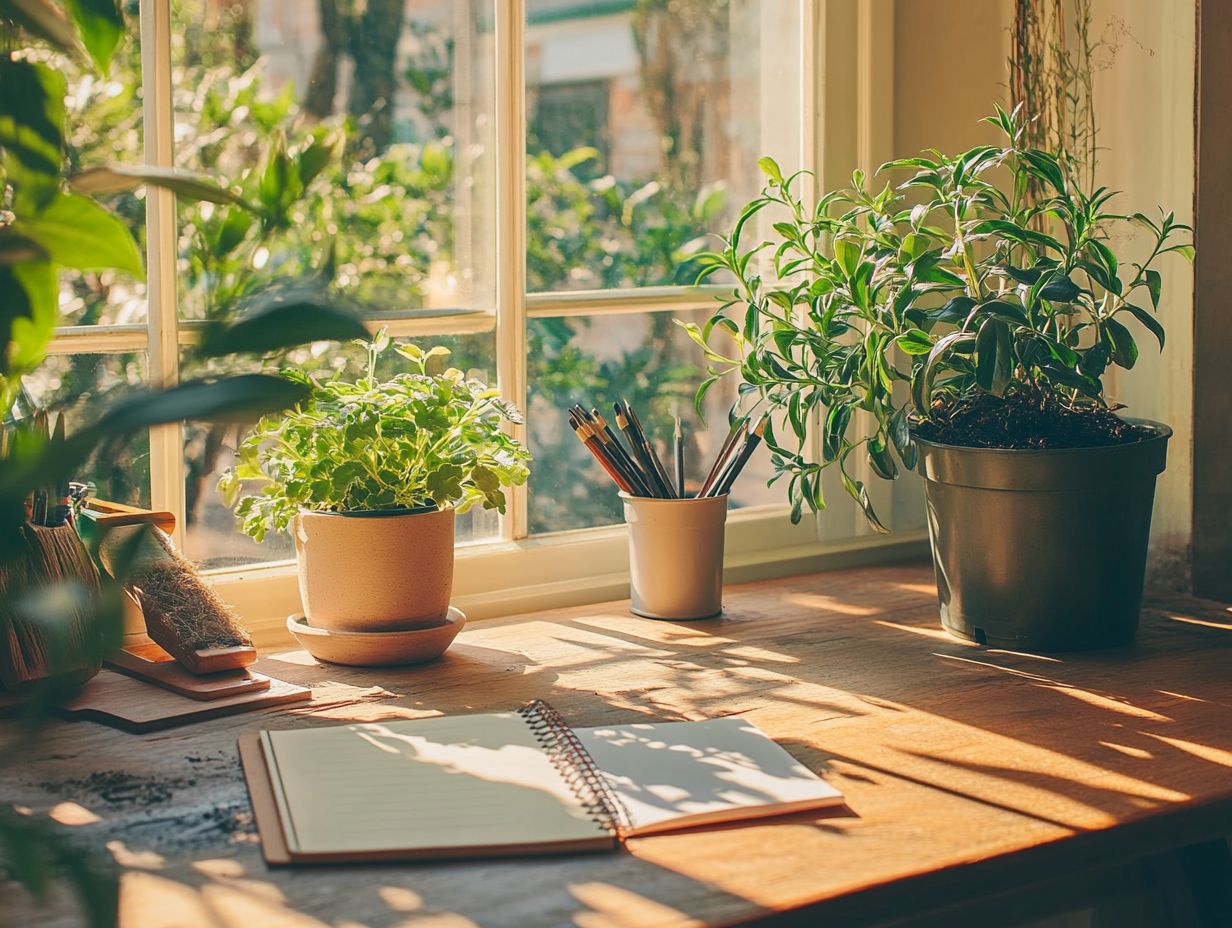
Some common houseplant issues include wilting, yellowing leaves, and leaf spots. To deal with wilting, ensure your plant is receiving enough proper watering and sunlight. For yellowing leaves, check for overwatering signs or nutrient deficiencies. Pests can be treated with natural remedies or store-bought insecticides.
2. How can I prevent pest infestations in my houseplants?
The best way to prevent pest infestations is to regularly inspect your plants for any signs of bugs or insects, such as aphids or mealybugs. You can also use natural deterrents like neem oil or introduce beneficial insects like ladybugs to your plants. Keeping your plants clean and free of debris can reduce the chances of pests.
3. Should I repot my houseplants if they are struggling?
Repot only if necessary. Check if the roots are overcrowded or if the soil feels compacted. If so, gently move your plant to a larger pot with fresh, well-draining soil.
4. How do I know if my houseplant needs more or less water?
To know if your plant needs more or less water, check the soil moisture. Stick your finger an inch into the soil. If it feels dry, it s time to water. If it’s still moist, wait a bit longer.
5. Can I use household products to care for my houseplants?
Certain household items, like coffee grounds and eggshells, can help your plants. Always do your research first. Make sure the product is safe. Some can cause fungal infections. Avoid mayonnaise or milk; they can attract pests and harm your plants.
6. How can I revive a dying houseplant?
To revive a dying houseplant, you need to figure out what’s wrong. Look for signs of pests, root rot, or nutrient issues. Once you identify the problem, provide the right care. This might include pruning, repotting, or adjusting light and water conditions. Patience and consistent care are vital for recovery.

